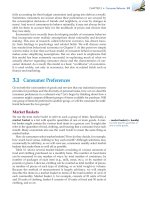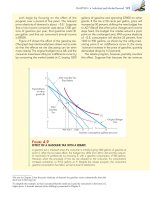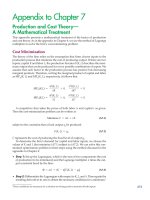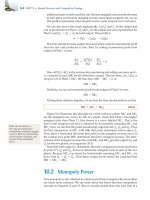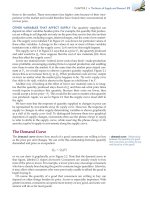(8th edition) (the pearson series in economics) robert pindyck, daniel rubinfeld microecon 262
Bạn đang xem bản rút gọn của tài liệu. Xem và tải ngay bản đầy đủ của tài liệu tại đây (80.98 KB, 1 trang )
CHAPTER 7 • The Cost of Production 237
equal to the increase in variable cost or the increase in total cost that results from
an extra unit of output. We can therefore write marginal cost as
MC = ⌬VC/⌬q = ⌬TC/⌬q
Marginal cost tells us how much it will cost to expand output by one unit. In
Table 7.1, marginal cost is calculated from either the variable cost (column 2) or
the total cost (column 3). For example, the marginal cost of increasing output
from 2 to 3 units is $20 because the variable cost of the firm increases from $78 to
$98. (The total cost of production also increases by $20, from $128 to $148. Total
cost differs from variable cost only by the fixed cost, which by definition does
not change as output changes.)
AVERAGE TOTAL COST (ATC) Average total cost, used interchangeably with
AC and average economic cost, is the firm’s total cost divided by its level of output,
TC/q. Thus the average total cost of producing at a rate of five units is $36—that
is, $180/5. Basically, average total cost tells us the per-unit cost of production.
ATC has two components. Average fixed cost (AFC) is the fixed cost (column
1 of Table 7.1) divided by the level of output, FC/q. For example, the average
fixed cost of producing 4 units of output is $12.50 ($50/4). Because fixed cost
is constant, average fixed cost declines as the rate of output increases. Average
variable cost (AVC) is variable cost divided by the level of output, VC/q. The
average variable cost of producing 5 units of output is $26—that is, $130/5.
We have now discussed all of the different types of costs that are relevant to
production decisions in both competitive and non-competitive markets. Now
we turn to how costs differ in the short run versus the long run. This is particularly important for fixed costs. Costs that are fixed in the very short run, e.g., the
wages of employees under fixed-term contracts—may not be fixed over a longer
time horizon. Similarly, the fixed capital costs of plant and equipment become
variable if the time horizon is sufficiently long to allow the firm to purchase
new equipment and build a new plant. Fixed costs, however, need not disappear, even in the long run. Suppose, for example, that a firm has been contributing to an employee retirement program. Its obligations, which are fixed in part,
may remain even in the long run; they might only disappear if the firm were to
declare bankruptcy.
• average total cost
(ATC) Firm’s total cost divided
by its level of output.
• average fixed cost
(AFC) Fixed cost divided by
the level of output.
• average variable cost
(AVC) Variable cost divided by
the level of output.
7.2 Cost in the Short Run
In this section we focus our attention on short-run costs. We turn to long-run
costs in Section 7.3.
The Determinants of Short-Run Cost
The data in Table 7.1 show how variable and total costs increase with output
in the short run. The rate at which these costs increase depends on the nature
of the production process and, in particular, on the extent to which production
involves diminishing marginal returns to variable factors. Recall from Chapter 6
that diminishing marginal returns to labor occur when the marginal product of
labor is decreasing. If labor is the only input, what happens as we increase the
firm’s output? To produce more output, the firm must hire more labor. Then, if
the marginal product of labor decreases as the amount of labor hired is increased
(owing to diminishing returns), successively greater expenditures must be made
In §6.2, we explain that
diminishing marginal returns
occurs when additional
inputs result in decreasing
additions to output.

